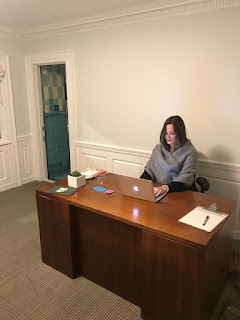This past Monday, I was spending some time in the sitting room on the first floor, working through the third stanza of a poem that had been giving me fits -- mainly because I couldn't find the right image to express a certain kind of healed brokenness. Just as I decided to take a break, a couple walked in. They were visiting from Asheville, North Carolina, a creative community I'd just spoken with my sister and mom (who also happened to be visiting me from North Carolina) about visiting later this month.
The couple introduced themselves, asked about my work, told me about their own lives. She is a writer, he a musician. Their daughter, also a writer, is in residency at UNC Chapel Hill. As we conversed, my mom and sister arrived with lunch.
Two days before, driving to El Cid to see some kitschy flamenco, we'd listened to a TED talk by Elizabeth Gilbert on the concept of genius. Gilbert notes that it's only fairly recently that artists take credit for (or, when it's not so great, disavow) their own work. For centuries before this ego-driven way of understanding creating, we seem to have understood genius as something like a personal fairy -- a visitor who arrived with a story, a picture, a song. If the work's great, genius; if the work's poor, genius. You see.
I gave the couple a tour of the house. As we looked out at the beach from one of the upstairs bedrooms, we talked about the city seagulls one often sees on the beach with injured legs that have healed into knobby, stubby (and thankfully secondary) appendages. The husband mentioned a haiku with which he was acquainted:
The one-legged man
watches the one-legged bird
as it flies away.
The haiku gave me an image: the footprints a stub-legged seagull has left on wet sand. Something like
< < < < < < < < < <
. . . . . . . . . .
and then, no prints at all.
-- Catherine Coan, 11/12/18





